A & J Vacuum Services: About Us
Your global leader in sales and service of High
Vacuum Equipment
Mission
A & J Vacuum Services is your trusted worldwide leader
in sales and service of High Vacuum and Laboratory Equipment, Vacuum Hardware,
Spare Parts, Vacuum Oils and Greases. Established in year 2000. Located in the
heart of the New York Metropolitan area, our focus is to deliver the best
customer support and service in our industry. With over a decade of experience,
A & J Vacuum Services is fully dedicated to the highest quality of customer satisfaction.
We sell and service highly regarded brands such as Pfeiffer Vacuum, Agilent Technologies, Edwards Vacuum, Adixen, Leybold Vacuum, Vacuubrand, Brandtech, Yamato, Ulvac, Anest Iwata, Becker, Alcatel, Apiezon and many more.
Our expertise allows us to provide best in class service for all of your all vacuum and laboratory needs. The equipment we service includes turbo molecular pumps, scroll pumps, rotary vane pumps, diaphragm pumps, Industrial dry pumps, helium leak detectors, vacuum gauges, and controllers.
Our client list includes companies such as NASA, Intel, Raytheon, Exxon, Seagate, Sony, Los Alamos National Laboratory, Boeing, the US Army, Johnson and Johnson, Nokia, Linde, and thousands of others across the globe.
We sell and service highly regarded brands such as Pfeiffer Vacuum, Agilent Technologies, Edwards Vacuum, Adixen, Leybold Vacuum, Vacuubrand, Brandtech, Yamato, Ulvac, Anest Iwata, Becker, Alcatel, Apiezon and many more.
Our expertise allows us to provide best in class service for all of your all vacuum and laboratory needs. The equipment we service includes turbo molecular pumps, scroll pumps, rotary vane pumps, diaphragm pumps, Industrial dry pumps, helium leak detectors, vacuum gauges, and controllers.
Our client list includes companies such as NASA, Intel, Raytheon, Exxon, Seagate, Sony, Los Alamos National Laboratory, Boeing, the US Army, Johnson and Johnson, Nokia, Linde, and thousands of others across the globe.
Technicians
Our companys technicians are highly qualified,
professionally trained, and dedicated to meeting the needs of every customer.
Whether you need to repair or purchase a single piece of equipment or large
multi-component system we have the capacity to meet your specific needs.
Equipment
Our advanced machinery enables us to handle all facets
of the service and repair process including; decontamination, cleaning, drying
and balancing. AJVS utilizes industry standard vibration analysis equipment
and advanced testing equipment to troubleshoot and minimize all equipment failures.
A & J Vacuum Services: Industries We Serve
Semiconductor Manufacturing and Research
A variety of vacuum systems, such as dry vacuum pumps, turbomolecular pumps, leak detectors, vacuum gauges and components are used to optimize performance across applications, ranging from light duty to the heaviest duty processes.
Applications include: Load lock, transfer chamber, metrology, lithography and EUV lithography, PVD process, PVD pre-clean, rapid thermal annealing, strip/ashing, dielectric etch, silicon conductor etch, metal conductor etch, PECVD and LPCVD, metal organic CVD, and atomic layer deposition.
A&J Vacuum Services specializes in the vacuum pump technologies that enable semiconductor manufacturing and research. We offer a full range of equipment, services and expertise to meet the vacuum product needs of the manufacture and R&D of the microelectronics devices sector.
Pharmaceutical & Medical Manufacturing and Research
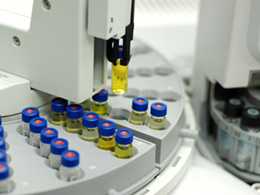 Pharmaceutical and medical research provides new
an innovative treatments for improving health and well-being. Pharmaceutical
R&D, as well as product and medical devices manufacturing is a technically
demanding industry, and utilizes vacuum technologies in numerous essential applications.
Pharmaceutical and medical research provides new
an innovative treatments for improving health and well-being. Pharmaceutical
R&D, as well as product and medical devices manufacturing is a technically
demanding industry, and utilizes vacuum technologies in numerous essential applications. A variety of vacuum systems, such as dry vacuum pumps, turbomolecular pumps, leak detectors, vacuum gauges and components are used to optimize performance across applications, ranging from light duty to the heaviest duty processes.
In manufacturing of medical devices, leak testing is frequently required as an integral part of the quality process. Packaging is also a critical component to ensure the quality and preservation of a drug, as leaks can spoil the product. Items tested include: Packaging, implants, prostheses, catheters, ostomy bags, optics, blisters, filters and bags. Other important application areas include: Plasma sterilization, vacuum autoclave sterilization, MRI, and high speed centrifuges. Vacuum pump technologies for pharmaceutical sciences are also utilized in vacuum drying ovens, vacuum filtration, vacuum pumped gas chromatography with mass spectrometers (GCMS), vacuum distillation, and low-pressure gas-phase infrared spectroscopy (IR).
A&J Vacuum Services supplies and services a full range of Vacuum Pump products and technologies for pharmaceutical and medical research and manufacturing.
Solar Cell and Photovoltaic Manufacturing and Research
 Solar cells or photovoltaic arrays are fabricated
in vacuum based technology processes. A solar panel or a photovoltaic array
is a linked collection of photovoltaic modules which are made of multiple
interconnected solar cells. Photovoltaic (PV) solar systems generate electricity
from sunlight without noise, pollution, or moving parts, producing clean and
reliable electricity used in commercial, residential and industrial facilities,
including the International Space Station.
Solar cells or photovoltaic arrays are fabricated
in vacuum based technology processes. A solar panel or a photovoltaic array
is a linked collection of photovoltaic modules which are made of multiple
interconnected solar cells. Photovoltaic (PV) solar systems generate electricity
from sunlight without noise, pollution, or moving parts, producing clean and
reliable electricity used in commercial, residential and industrial facilities,
including the International Space Station. Thin film manufacturing and research is at the center of the solar energy industry. Turbomolecular pumps are utilized for ultra-clean and high reliability vacuums required in manufacturing. Vacuum technology applications include silicon cell and thin film panel manufacturing, film deposition, and utilization of mass spectrometers.
A&J Vacuum Services specializes in the high vacuum pump technologies empowering solar cell manufacturing. We sell and service vacuum pumps used by photovoltaic manufacturing and research, including high vacuum pumps, dry scroll vacuum pumps, oil sealed rotary vane pumps. A&J Vacuum Services also carry parts and repair kits for all the major vacuum pump manufacturers like Oerlikon / Leybold, Adixen / Alcatel, Edwards Vacuum, Galileo and used in solar cell manufacturing and research.
Biofuel Research and Manufacturing
 Biofuels are alternative fuels produced from renewable
resources. For a fuel to be classified a biofuel it must contain over 80 percent
renewable materials. The most common use for biofuels is as liquid fuel for
automotive transport, such as ethanol, or biodiesel. New forms of biofuels
are also under research and experimentation for renewable jet fuel for aircraft
flight. Biodiesel is obtained via a transesterfication proces commonly from
either newly grown sustainable farm products such as palm oil, rapeseed oil,
and soy bean oil, or from recycled cooking oils, fats, and fatty acids.
Ethanol is produced via fermentation from various biological materials, s
uch as sugar cane. The research and manufacturing of sustainable biofuels,
such as biodiesel, is expanding worldwide with the goal to replace more of
the fossil based petroleum products.
Biofuels are alternative fuels produced from renewable
resources. For a fuel to be classified a biofuel it must contain over 80 percent
renewable materials. The most common use for biofuels is as liquid fuel for
automotive transport, such as ethanol, or biodiesel. New forms of biofuels
are also under research and experimentation for renewable jet fuel for aircraft
flight. Biodiesel is obtained via a transesterfication proces commonly from
either newly grown sustainable farm products such as palm oil, rapeseed oil,
and soy bean oil, or from recycled cooking oils, fats, and fatty acids.
Ethanol is produced via fermentation from various biological materials, s
uch as sugar cane. The research and manufacturing of sustainable biofuels,
such as biodiesel, is expanding worldwide with the goal to replace more of
the fossil based petroleum products. A variety of vacuum systems, such as dry vacuum pumps, turbomolecular pumps, leak detectors, vacuum gauges and components are used to optimize performance across applications, ranging from light duty to the heaviest duty processes.
A&J Vacuum Services provides vacuum pump systems for laboratory research experiments and biofuel production worldwide, ranging from smaller labs to large installations. The liquid ring pump is essential for biodiesel fuel processes. At A&J Vacuum Services our expertise includes and we sell and service liquid ring pumps, as well as rotary vane, once-thru-oil rotary vane, and dry vacuum pumps for biofuel research and manufacturing.
Physics Research
 Physics is the scientific research of matter and energy and
how they interact with each other. Energy takes the form of motion, light,
electricity, radiation, and gravity, among many forms. As an experimental science,
physicists create theories which are tested against observations. Broadly,
its goal is the understanding how the universe behaves from the sub-atomic
level to entire galaxies.
Physics is the scientific research of matter and energy and
how they interact with each other. Energy takes the form of motion, light,
electricity, radiation, and gravity, among many forms. As an experimental science,
physicists create theories which are tested against observations. Broadly,
its goal is the understanding how the universe behaves from the sub-atomic
level to entire galaxies. Advances in sub-disciplines of physics concretely translate into technological advances. For example, advances in understanding electromagnetism have led to the ever increasing use of electronic devices. Greater knowledge of thermodynamics has led to the development of motorized transport, and mechanics and applied mechanics have further contributed to major inventions, such as railways, airplanes, nuclear reactors, petroleum refineries, composite materials and medical implants, among countless examples.
Vacuum pump technology is used extensively within all the subfields of physics. For example, turbomolecular pumps are widely used in high-energy physics, fusion technology and general UHV research. Also mechanical roughing vacuum pump technologies are used by physicists, including: Rotary vane pumps, rotary piston pumps, dry semiconductor pumps, dry scroll vacuum pumps, diaphragm vacuum pumps and roots blower booster vacuum pumps. They all have an established role in physics research of today.
The different vacuum technologies sold and serviced by A&J Vacuum Services, are present in major physics research facilities around the world, and directly contribute to new discoveries and technologies of tomorrow.
Chemistry Research
 Chemistry is a physical science concerned with the
structure, composition and properties of matter, and the changes during chemical
reactions. Chemistry can be viewed as a complex application of physics. Disciplines
within chemistry include: Inorganic chemistry, organic chemistry, biochemistry,
physical chemistry i.e. the energy-related studies of chemical systems at macro,
molecular and submolecular scales, and analytical chemistry, dealing with analysis
of material samples. Vacuum technology is used extensively within all the disciplines
of chemistry. Vacuum conditions and methods are especially important to chemists
who specialize in experimental research and theory, and in new phenomena and in
new discoveries.
Chemistry is a physical science concerned with the
structure, composition and properties of matter, and the changes during chemical
reactions. Chemistry can be viewed as a complex application of physics. Disciplines
within chemistry include: Inorganic chemistry, organic chemistry, biochemistry,
physical chemistry i.e. the energy-related studies of chemical systems at macro,
molecular and submolecular scales, and analytical chemistry, dealing with analysis
of material samples. Vacuum technology is used extensively within all the disciplines
of chemistry. Vacuum conditions and methods are especially important to chemists
who specialize in experimental research and theory, and in new phenomena and in
new discoveries. Chemists worldwide rely on, and employ the wide range of vacuum technologies and products from A&J Vacuum Services. These include: Turbo molecular pumps, cryo pumps, hybrid turbo drag-molecular pumps, rotary vane pumps, dry semiconductor pumps, dry scroll vacuum pumps, and rotary piston pumps.
Analytical Instrumentation
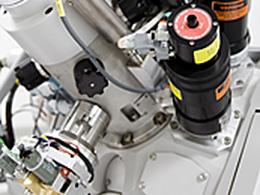 The demand for high performance vacuum pumps is greater
than ever for analytical instrumentation. Electron Microscopy (SEM, TEM), Focused
Ion-beam Systems (FIB) and Surface Analysis Modern focused-beam systems such as
SEMs, TEMs and FIBs utilize columns that project electrons or ions onto microscopic
samples for analysis. Turbo molecular pumps are a key component in modern focused-beam
systems because they offer fast, oil-free air evacuation of large sample chambers.
Oil-free operation is a major requirement of many modern analysis applications.
The demand for high performance vacuum pumps is greater
than ever for analytical instrumentation. Electron Microscopy (SEM, TEM), Focused
Ion-beam Systems (FIB) and Surface Analysis Modern focused-beam systems such as
SEMs, TEMs and FIBs utilize columns that project electrons or ions onto microscopic
samples for analysis. Turbo molecular pumps are a key component in modern focused-beam
systems because they offer fast, oil-free air evacuation of large sample chambers.
Oil-free operation is a major requirement of many modern analysis applications. A mass spectrometer can be used to analyze the composition of a gas mixture in a production system. Mass spectrometers such as LCMS, GCMS, ICPMS and FTMS, are highly sophisticated and sensitive measurement tools used in both quantitative and qualitative analysis. They are used to determine the elemental compositions of physical samples, in the chemistry, material science, biomedical, biopharmaceutical and environmental research fields.
Residual gas analysis is required to evaluate the kind of gases which occur in vacuum process chambers. Applications include, both residual gas analysis for high-vacuum applications and ultra-high vacuum applications.
A&J Vacuum Services offers a wide range of vacuum pumps and mass spectrometer systems designed to meet the needs of the analytical instrumentation market.
Vacuum Metallurgy
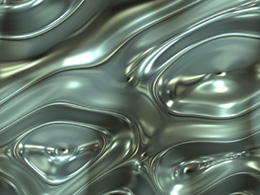 Vacuum metallurgy takes place with melting, shaping,
and treating of metals and alloys under reduced pressure that ranges from subatmospheric
vacuum pressure to ultra-high vacuum. The process of separating pure metal from mixed
metallic particles, alloys, intermetallic and refractory metals by vacuum metallurgy
is that the vapor pressures of various metals at the same temperature are different.
The metal with high vapor pressure and low boiling point can be separated from the
mixed metals through distillation or sublimation. There are three basic reasons
for vacuum processing of metals: Elimination of contamination from the processing
environment, reducing of the level of impurities in the product, and deposition
with a minimum of impurities.
Vacuum metallurgy takes place with melting, shaping,
and treating of metals and alloys under reduced pressure that ranges from subatmospheric
vacuum pressure to ultra-high vacuum. The process of separating pure metal from mixed
metallic particles, alloys, intermetallic and refractory metals by vacuum metallurgy
is that the vapor pressures of various metals at the same temperature are different.
The metal with high vapor pressure and low boiling point can be separated from the
mixed metals through distillation or sublimation. There are three basic reasons
for vacuum processing of metals: Elimination of contamination from the processing
environment, reducing of the level of impurities in the product, and deposition
with a minimum of impurities. A&J Vacuum Services supplies a full range of vacuum products for the successful application of vacuum metallurgy for clients throughout the world.
Electron Beam Welding
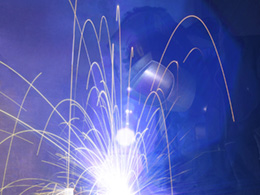 Electron Beam Welding (EBW) is a welding process producing
a coalescence of metals with heat from a concentrated beam of high velocity electrons.
The EBW process is made possible by the use of vacuum pumps fitted for a vacuum
chamber which houses the electron beam gun and the metals to be joined. The kinetic
energy is transformed into heat on impact on the metal, instantly vaporizing it to
a molten stage. Near 25,000 °C heat is generated in the metal as it is bombarded
by a stream of high-velocity electrons. This makes it possible to weld much
thicker workpieces than is possible with most other welding processes. As the
electron beam from the electron gun is tightly focused, the total heat input
is much lower than that of any arc welding process. As a result, the effect of
welding on the surrounding material is minimal, and the heat-affected zone is
small in comparison. The metals most often welded are the super alloys, the
refractory metals, the reactive metals, and the stainless steels.
Electron Beam Welding (EBW) is a welding process producing
a coalescence of metals with heat from a concentrated beam of high velocity electrons.
The EBW process is made possible by the use of vacuum pumps fitted for a vacuum
chamber which houses the electron beam gun and the metals to be joined. The kinetic
energy is transformed into heat on impact on the metal, instantly vaporizing it to
a molten stage. Near 25,000 °C heat is generated in the metal as it is bombarded
by a stream of high-velocity electrons. This makes it possible to weld much
thicker workpieces than is possible with most other welding processes. As the
electron beam from the electron gun is tightly focused, the total heat input
is much lower than that of any arc welding process. As a result, the effect of
welding on the surrounding material is minimal, and the heat-affected zone is
small in comparison. The metals most often welded are the super alloys, the
refractory metals, the reactive metals, and the stainless steels. A&J Vacuum Services sells and services a full range of vacuum pumps for electro-beam welding, serving clients around the world for their EBW vacuum needs.
Tool Coatings
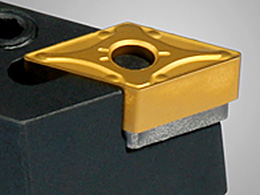 Tool coatings are used to improve hardness and wear
resistance of tools. Tool coatings are applied in a high production environment
requiring a reliable and robust vacuum solutions.
Tool coatings are used to improve hardness and wear
resistance of tools. Tool coatings are applied in a high production environment
requiring a reliable and robust vacuum solutions. Diamond-like carbon (DLC) coatings, impart their properties to provide some of the properties of diamond to surfaces of almost any material. Tooling components, such as endmills, drill bits, dies and molds often use DLC. The application of DLC coatings is also used in engines of modern supersport motorcycles, Formula 1 race cars, NASCAR vehicles, and as a coating on hard-disk platters and hard-disk read heads to protect against head crashes.
Physical Vapor Deposition (PVD) machining and tooling coatings are widely used to increase the life and productivity of production cutting tools. PVD coated cutting tools can be run faster reducing cycle times and enabling the production of more components in less time and PVD coatings are resistant to all forms of wear increasing the life of cutting tools reducing tool-changing costs.
Chemical Vapor Deposition (CVD) is an atmospherically controlled process conducted at elevated temperatures in a CVD reactor. Many manufacturing applications use CVD coatings for a wear-resistant coating. These include carbide milling and turning inserts, wear components, certain plastic processing tools, among others. The most common application for CVD coating is in metal-forming tools. CVD coatings provide excellent resistance to the types of wear and galling.
Thermoreactive Diffusion (TD or TRD) is a high temperature coating process for producing metal carbides, typically vanadium carbide. This is a multi-stage coating utilized on the surface of a carbon-containing substrate. Diffusion type bond of TD coatings provide a superb adhesion between the metal carbide layer and the substrate.
A&J Vacuum Services sells and services a full range of vacuum pumps to the exact requirements of these coating applications.
U.S. Defense Research
 The prevention of technological surprise is key aspect
of maintaining this superiority. By sponsoring revolutionary, high-payoff research
and bridging the gap between fundamental discoveries and their military use,
the U.S. defense research is at cutting edge of innovation. Vacuum pump technologies
are used extensively for research within all the branches of military
contributing to maintaining its technological edge.
The prevention of technological surprise is key aspect
of maintaining this superiority. By sponsoring revolutionary, high-payoff research
and bridging the gap between fundamental discoveries and their military use,
the U.S. defense research is at cutting edge of innovation. Vacuum pump technologies
are used extensively for research within all the branches of military
contributing to maintaining its technological edge. The prevention of technological surprise is key aspect of maintaining this superiority. By sponsoring revolutionary, high-payoff research and bridging the gap between fundamental discoveries and their military use, the U.S. defense research is at cutting edge of innovation. Vacuum pump technologies are used extensively for research within all the branches of military contributing to maintaining its technological edge.
A&J Vacuum Services also sells and services the vacuum technologies which contribute to maintaining the technological superiority of this innovative research.
Contact

A&J Vacuum Services
16 Somerset Place, Clifton, NJ 07012

Customer Service
Phone: 973-249-0854, Fax: 973-249-0855

Service Hours
8:00am to 5:00pm, Monday thru Friday EST
High Vacuum Technical Library
All trademarks, trade names or logons mentioned or used are the property of their respective owners.






